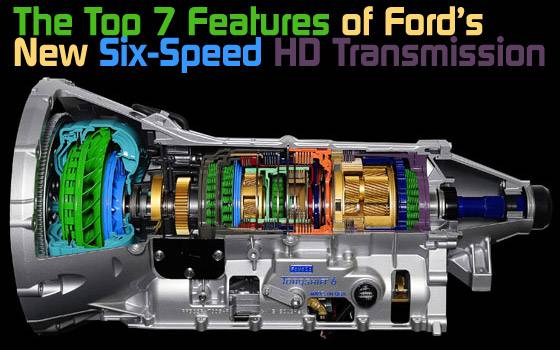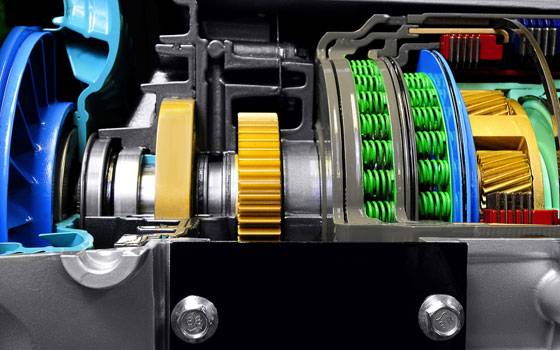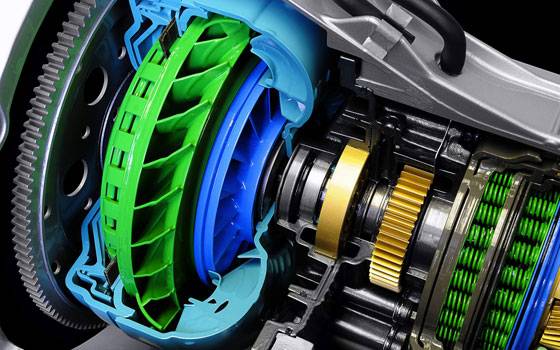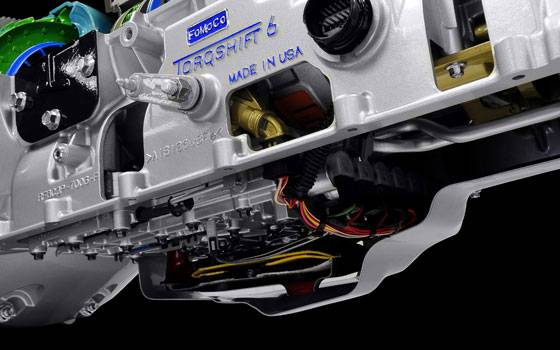The Top 7 Features of Ford’s All-New 6R140 Six-Speed Heavy-Duty Transmission

Ford’s technically advanced and unconventional new 6.7-liter Power Stroke V-8 turbocharged diesel will debut early next year in the 2011 Ford F-Series Super Duty lineup. No matter how powerful and sophisticated Ford’s new oil burner is engineered to be, it won’t be considered successful without a transmission capable of managing all of that horsepower and torque as well as efficiently sending that power to the wheels to tow and haul heavy loads. That’s where Ford’s new 6R140 TorqShift six-speed automatic gearbox comes in.
Like the new Power Stroke V-8, Ford designed and engineered the 6R140 entirely in-house. Al Bruck, Ford’s 6R140 transmission engineering manager, says it’s a clean sheet design and represents the next generation beyond the 2008-10 Super Duty’s current 5R110 five-speed automatic transmission.
“This isn’t an evolutionary design with limitations and we built from that,” Bruck said. “Our benchmark for the 6R140 is the current Allison 1000 transmission used in GM’s heavy-duty pickups. We’ve got greater capability than the Allison, and we’re about 25 pounds lighter.”
The dry weight of the 6R140 is approximately 325 pounds and about 350 pounds when filled with transmission fluid.
Bruck says that it’s not a single component that makes the 6R140 competitive but a series of interdependent features that add up to make this the most capable transmission Ford has ever offered in the Super Duty. We’ve broken them down into the top seven features of Ford’s all-new 6R140 heavy-duty automatic transmission.

1. Works with Ford’s Gas and Diesel Engines
Unlike GM’s and Chrysler’s heavy-duty trucks, which use separate transmissions for gas and diesel powertrains, Ford’s latest HD pickups continue to share a single transmission for both applications. The 6R140 has to be flexible and intelligent enough to accommodate the low-end grunt of the 6.7-liter diesel and higher-revving peak power curve of Ford’s new 6.2-liter V-8 gasser.
How does Ford adapt the transmission for each engine? The 6R140 uses a different torque converter, clutch plates, friction paper and shift schedule software calibrations depending on the motor. That’s it.
2. Single-Piece Housing
While other transmission housings are comprised of multiple pieces bolted together, like GM’s three-piece case for the Allison 1000 transmission, the 6R140 uses a single-piece, deep-skirted case. Ford says the advantages of this design are that it’s quieter, saves weight by doing away with fasteners between body pieces and eliminates the possibility of fluid leak points at the join points.
“From the back flange of the engine block to the slip yolk at the back of the transmission is a single-piece casting,” Bruck said. “It’s a very efficient use of material for improved NVH and leak performance. It’s also much stiffer since we can eliminate the points where bending might occur.”
The only points where the transmission can leak are at the rear seal and the front seal near the torque converter.
Ford has also designed large drainage openings inside the housing to circulate transmission fluid in large volumes between the gears and clutches and fluid sump at the bottom of the housing. New friction plates in the clutches help to quickly drain fluid to reduce fluid resistance.
In the event that the transmission requires service, instead of disassembling the case like a conventional transmission, nearly all jobs start and end at the torque converter side of the gearbox. The 6R140’s components are modularly constructed to help facilitate removal from the barrel.
3. Improved Fuel Economy
Fuel economy is at the top of most truck operator’s minds these days, and the transmission plays a critical role optimizing it. The 6R140 uses several technical tricks to make promised improvements to the Super Duty’s mileage.One way fuel economy has been improved in the 6R140 is through the use of an early lockup closed piston torque converter, Bruck said.
The torque converter in an automatic transmission does the same job as a clutch in a manual transmission.
How does this improve mileage? When a torque converter is disengaged, the engine is still running but it’s not driving the wheels via the transmission, so fuel is wasted. This is important if you’re driving a vehicle with an automatic transmission, so it won’t stall at a stoplight. When you get going again, engaging the torque converter at a lower rpm means power can be sent to the wheels sooner, thereby improving fuel economy. Think of it as taking some of a manual transmission’s inherent fuel economy advantages and applying them to an automatic gearbox.
“The lockup [strategy] depends on pedal positioning,” Bruck said. “We’ve done a lot of work monitoring fuel rates at different speeds, different pedal rates and different gears to optimize the 6R140 for both gas and diesel.”

As you might expect, there are different lockup strategies for the gas and diesel engines.
“There are advantages to not locking it up as early with the gas engine as we do for the diesel,” he said. “The way we do it for the diesel, in full automatic mode, during a normal upshift, is to lock the converter between third and fourth and stay locked up through sixth. We’re more aggressive locking up the torque converter earlier in tow/haul mode and manual mode.”
Tow/haul mode is used in HD automatic transmissions to hold gears longer and keep engine rpms higher during towing and hauling situations so adequate power is available at all times, especially during upshifts to help prevent the truck from lugging after the shift.
Manual mode allows the driver to manually shift the automatic transmission up and down like a manual gearbox as long as the transmission doesn’t exceed the engine’s rpm redline or stall the engine.
The torque converter also features a long-travel steel turbine damper that’s welded directly to the torque converter’s turbine. The damper, which is actually a set of springs arranged in a square pattern, limits the transmission of inertial forces produced by the 6.7-liter V-8, so they aren’t transmitted to the transmission’s input shaft all at once when the torque converter is locked or open. The damper allows the powertrain to idle as low as 900 rpm.
“The long-travel damper is like a long spring body that can wind up as rpms drop and diesel torque increases,” Bruck said. “And the lower the engine speed, the better the fuel economy.”
Like other competitive six-speed transmissions, the 6R140 offers two overdrive gears to improve fuel economy at highway speeds. The overdrive gears help the truck lope along at lower engine rpms.
4. Range Select and Manual Shift Functions
If a Super Duty driver wants custom control over the 6R140, they can switch from full automatic or tow/haul modes into Progressive Range Select or Manual modes.Range Select is activated via a toggle on the shift lever that allows the customer to reduce the range of available gears while in Drive. When the customer “taps” down into Range Select mode, the display shows the available gears and highlights the current gear state. This feature allows the driver to limit use of upper gears when heavily loaded or while towing on grades. It’s especially helpful in terrain that includes constant hills when towing.
In manual mode, the driver can select the exact gear they desire, as long as they don’t go over redline. The display will show the selected gear, and the control system will lock the torque converter and hold that gear for a full manual transmission feel.Manual mode is Ford’s way of making up for the loss of a standard ZF six-speed manual transmission, which goes away for 2011.
5. Live Drive Power Takeoff
Ford says the 6R140 transmission will be the first gearbox in the segment to offer what it calls Live Drive Power Takeoff.
Power Takeoff is used to power auxiliary tools, like generators or salt spreaders, off of the engine.
By linking the PTO’s output gear directly to the engine crank via a flex-plate connected to the torque converter housing, the PTO output gear continues to turn as long as the engine is turning, even if the truck is completely stopped and the torque converter is disconnected to keep the engine from stalling. In the outgoing 5R110, the PTO is linked directly to the turbine shaft.
“It’s capable of mobile and stationary PTO,” Bruck said. “This will enhance the capability of PTO products that are available today.
6. New Ravigneaux Powerflow Gearset

The 6R140 uses a new tough sinter-brazed Ravigneaux planetary gearset to carry engine torque without artificially limiting torque at launch to preserve transmission hardware. It’s a stout compound set of interconnected gears that acts as a two-in-one gearset, with one planetary carrier that’s common to two sets of planetary pinions, two sun gears and one common ring gear. It’s also capable of handling the high shift speeds of the gas engine and high torque loads of the 6.7-liter diesel.
“This gearset has plenty of headroom,” Bruck said. “It’s not stretched with our launch torque limits. When you see it side by side with the Allison’s gearset, you’ll say that these guys are playing in the same sandbox.”
The powerflow gearset’s housing is made from powdered metal. Normally used to create components like an engine’s connecting rods, a metal powder is poured into a mold and heavily compressed with a mating die. When it’s removed, a binder holds the powder together; it’s then sintered into its final form, which is nearly as dense as steel. It can be double-pressed again after sintering to make it stronger through greater density. Powdered metal provides all of the features of a steel part without requiring machining.
A Ford-patented rocker one-way clutch is integrated with the torque carrier and helps improve 1-2 shift quality through the gearset. It’s carried over from the 5R110 transmission.
7. 150,000-Mile Maintenance Schedule
To help lower operating costs, the 6R140 uses an internal “dual-media” filter that’s split into two mesh components – a coarse-grained filter and a fine-grained filter. The coarse-grained filter cleans about 90 percent of the transmission fluid in the gearbox while the fine-grained filter continuously cleans about 10 percent of the volume. Over time, both large and small contaminants are removed from the fluid, extending its maintenance cycle to 150,000 miles. For comparison, the current 5R110 has a 60,000-mile change interval.
“The concept is that over time you get a very effective cleaning,” Bruck said. “You don’t have to draw everything through the fine media, which is very inefficient and doesn’t work well in cold conditions. The dual-media setup uses a pressure balance to draw fluid into the fine media while everything goes through the coarse media. You reach an equilibrium of very clean fluid over time.”

The internal dual-media filter removes the need for an external filter, which also eliminates another potential leak point for the transmission.
“We studied doing a spin-on [filter], but the numbers we collected proved we could do it all internally,” he said. “Now we’re working to see if we can push the [maintenance interval] number even higher.”
One interesting point about the transmission fluid used in the 6R140 is that Ford has created a new standard that will see most of its vehicles use the same transmission fluid regardless of application. Transmission fluid for the Super Duty will be the same as the Ford F-150 half-ton pickup and other vehicles like the Ford Fusion sedan and Ford Escape.
“There’s been a lot of work done to migrate all of the vehicles to the same common fluid,” Bruck said.
Cars.com’s Editorial department is your source for automotive news and reviews. In line with Cars.com’s long-standing ethics policy, editors and reviewers don’t accept gifts or free trips from automakers. The Editorial department is independent of Cars.com’s advertising, sales and sponsored content departments.
Featured stories




